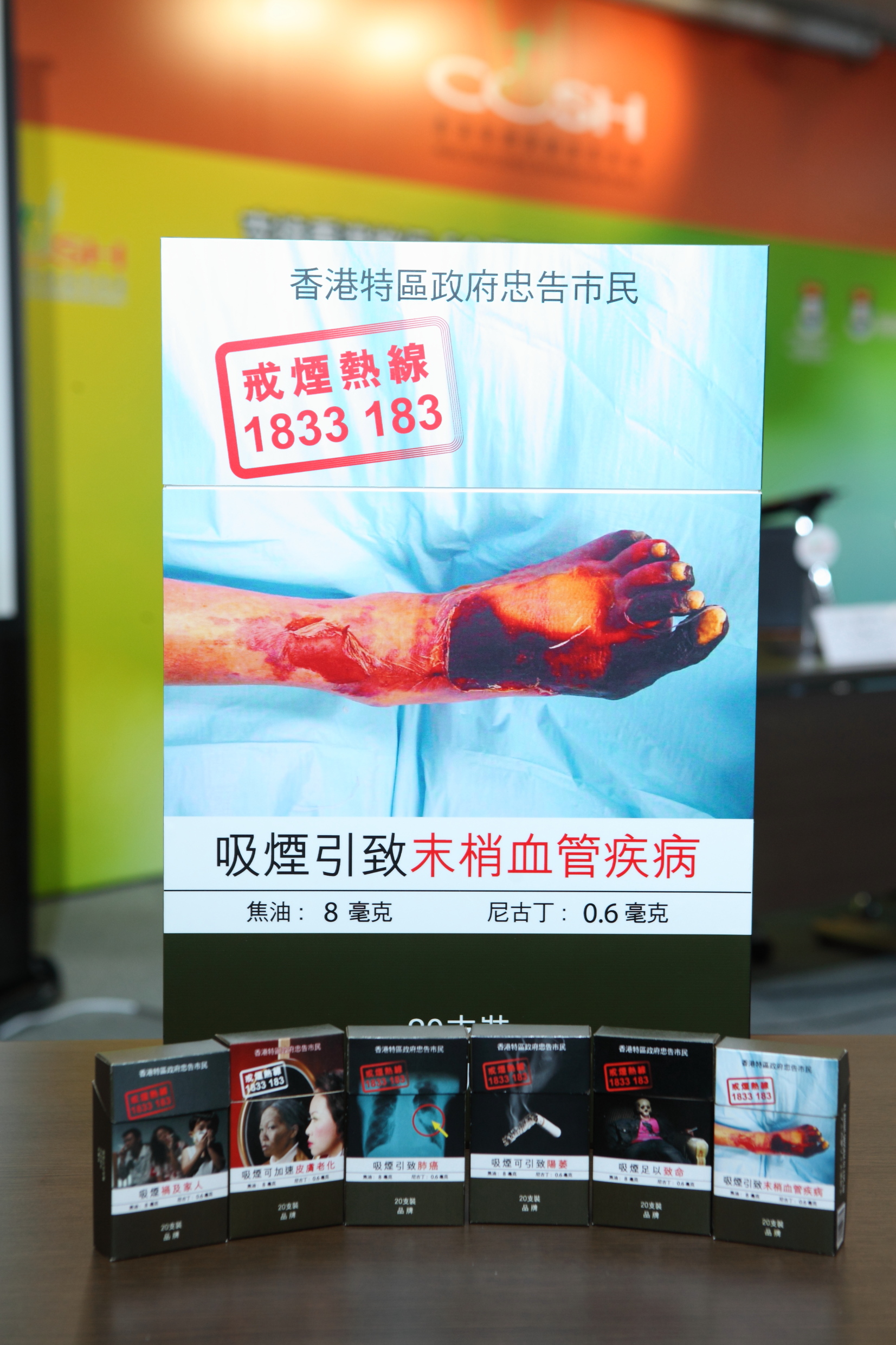31 May is the World No Tobacco Day, Hong Kong Council on Smoking and Health (COSH) would like to take this chance to advocate the implementation of plain packaging of tobacco products in Hong Kong. This is to raise the public awareness on tobacco harm, as well as to reduce the attractiveness of cigarette packs to youngsters and smokers.
World Health Organization (WHO) has designated “Tobacco industry interference” as the theme of this year’s World No Tobacco Day (31 May), which aims to expose and counter the tobacco industry's brazen and increasingly aggressive attempts to undermine the WHO’s Framework Convention on Tobacco Control. These attempts impose serious danger to public health.
Hong Kong has adopted pictorial health warning label on tobacco packages since 2007, requiring to covering 50% of the main sides of the cigarette pack. But the tobacco companies continue to use different designs on packages to attract consumers. Ms Lisa LAU, MH, JP, COSH Chairman claims that COSH will advocate the government to implement plain packaging of tobacco products in Hong Kong, in order to prohibit tobacco companies from promoting sales through fancy design on cigarette packs.
Lisa LAU says, “Despite Hong Kong is one of the cities with the lowest smoking prevalence in the world, daily smoking population is still around 657,000 people, while over 5,700 smokers died of smoking attributed diseases per year and the annual expenditure on health cost of smoking reaches HK$5.3 billion. Health warning must be strengthened.”
Researches on plain packaging have been conducted around the world, showing the effectiveness to make cigarettes unappealing, especially for adolescents, thus reducing the prevalence and up-take of smoking. Plain packaging is an extension of current pictorial health warning. Rather than covering 50% of the main sides of the cigarette pack, the pictorial health warning would be expanded into 75% or above of the main sides of the cigarette pack. In addition, all forms of tobacco branding should be labeled exclusively with simple unadorned text. This entails that trademarks, graphics and logos be detached from cigarette packs, except for the brand name that is displayed in a standard font size, colour and location on the package. The packaging should not contain colour and should include only the content and consumer information, such as toxic constituents, and health warnings required by law. Quitline should also be displayed at a prominent position.
Australia is the first country to adopt plain packaging in the world, with effective from Decemeber this year. Ms Fiona SHARKIE, Executive Director of Quit Victoria, who played an active role in the implementation process in Australia, shares the experience and challenges on the press conference. Plain packaging was announced in Australia in April 2010 and the Bill passed through Parliament in November 2011.
Fiona SHARKIE says, “Tobacco industry launched an unprecedented large-scale advertising campaign to deter the government from implementing plain packaging in Australia. They claimed that plain packaging is no use in reducing the prevalence of smoking. On the other hand, they took legal actions against Australian government, claiming substantial compensation for the loss of the company’s trademarks and investments. These actions have not deterred the Australian government, who has a firm stand for the sake of public health.”
Prof LAM Tai-hing, JP, Director of School of Public Health, The University of Hong Kong, indicates that most of the smokers underestimate the very high risk of deaths due to smoking. We must promote the tobacco harm to the public through education and strengthen the health warning on cigarette packs. Prof LAM says, “Hong Kong has now about 657,000 daily smokers and half of them, i.e. 329,000 will be killed by smoking. On average, smoking shortens the life span of smokers for 15 years. Secondhand smoke also influences the health of family.” Cigarette pack is an important advertising medium for tobacco companies. Expansion of pictorial health warnings can further limit the promotional effect of cigarette packs and refrain youngsters from up-taking smoking because of brand effects.
The implementation of plain packaging is a world trend. Framework Convention on Tobacco Control (FCTC), an evidence-based treaty in public health was introduced by WHO. To reduce the epidemic of tobacco consumption and enact FCTC, WHO implemented six effective tobacco control measures under a guiding principle named MPOWER. The W means “Warn about the dangers of tobacco”. Professor Judith MACKAY, SBS, OBE, JP, Senior Adviser, World Lung Foundation, says “As few tobacco users understand the full extent of their health risk, it is necessary to warn about the dangers of tobacco and health warning labels had been introduced for decades in different countries. Canada was the first country to introduce pictorial health warning, followed by other countries. Hong Kong has adopted 6 types of pictorial health warning label in 2007. The latest trend will be the implementation of plain packaging.”
Prof Sophia CHAN, COSH Vice-chairman cum Professor in Nursing and Director of Research, School of Nursing, The University of Hong Kong, reiterates that multi means should be used to further spread smoke-free messages in Hong Kong. Prof CHAN says, “Control on cigarette pack design is one of the effective ways. COSH advocates the implementation of plain packaging in Hong Kong. We also suggest to adopt a new set of pictorial health warning labels, as well as introduce quitline on cigarette packs to encourage smokers to quit smoking.” COSH will conduct feasibility study on adopting plain packaging in Hong Kong from different aspects and understand the view of public and seek public support on plain packaging through policy survey. Plain packaging can make cigarettes less appealing to children and teenagers and stop them from up-taking smoking.


